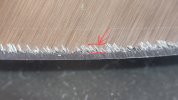- Joined
- Oct 24, 2018
- Messages
- 182
Reprofiling a blade with my Wicked Edge Pro I started at 50 grit stones and progressed to 400. But the gouges from the lower grit remains on the primary bevel ABOVE the secondary bevel no matter how much I sharpen with finer grit stones.
This isn't the common issue of not removing all the grind lines of the previous grit on the secondary bevel before changing grit.
I didn't change the angle throughout the progression but wondering if I should have started with a wider angle and adjusted narrower as I went to finer stones to consume the transition between the primary and secondary bevel.
Anyone with a WE notice this problem? This is on AEB-L but I don't think that matters.
This isn't the common issue of not removing all the grind lines of the previous grit on the secondary bevel before changing grit.
I didn't change the angle throughout the progression but wondering if I should have started with a wider angle and adjusted narrower as I went to finer stones to consume the transition between the primary and secondary bevel.
Anyone with a WE notice this problem? This is on AEB-L but I don't think that matters.

